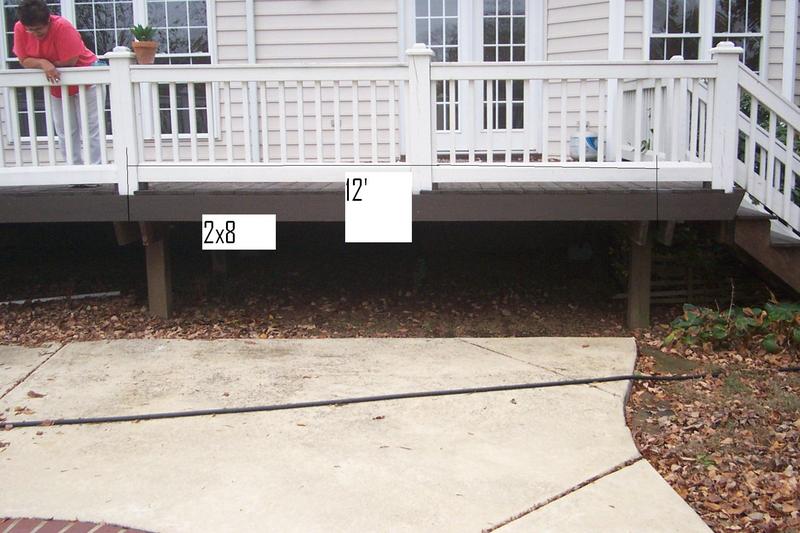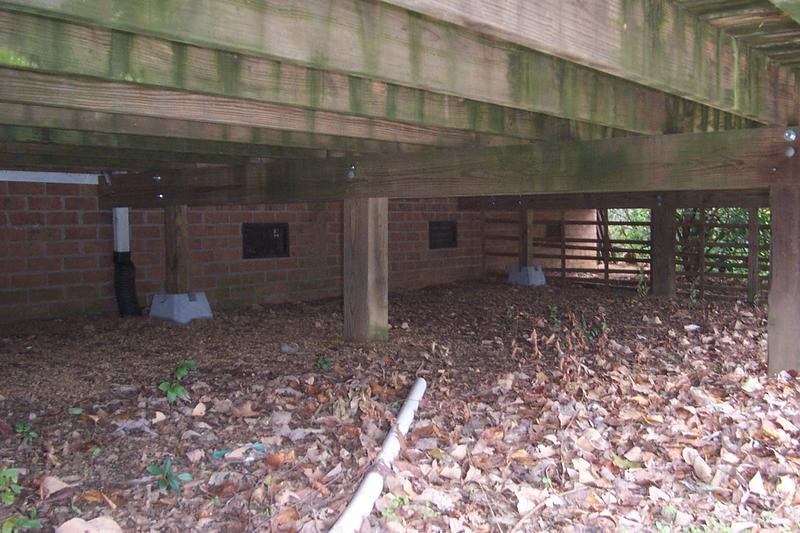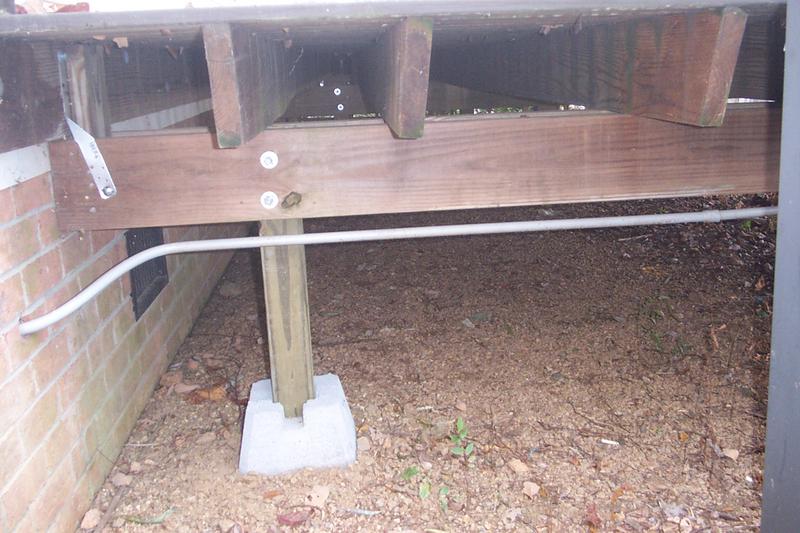The deck failed inspection because of the attachment of the girder to the ledger board. orginally it was only nailed to a 2x6 that was nailed to the ledger board above. I suspect at sometime this deck was rebuilt and lowered. The homeowner/contractor repaired the attachement using a simpsons strong time and bolts as shown in the first picture. This failed the reinspection, The second picture shows the follow up repair adding a post bolted to the girder with a deck block as the footer. This passed inspection. I have to question this as the span between posts is 12’ and the joists are 2x8. It seems that the deck block does not have a large enough foot print and the span of the joists is questionable. Thoughts on this?
IRC Spans:
Based on IRC T502.3.1(2) and 502.8.1
2X8 on 12" centers 14’2" span
2X8 on 16" centers 12’7" span
2X10 on 12" centers 17"9" span
2X10 on 16" centers 15’5" span
- 40lb. live load
Obviously the posts on the post blocks are an improvement. Better than nothing. I’d be more concerned with the fact the joists aren’t properly tied to the beams, they are beginning to “tilt”. Just a crappy deck job all around if you ask me.
This may be helpful:
http://www.awc.org/Publications/DCA/DCA6/DCA6-09.pdf
Who is making the “pass/fail” pronouncements?
My exact question Larry, I would still write this deck construction up hard the way it is.
Who’s been failing or passing this deck? 
When I do an inspection ,I write my report and it would include the deck .
If it is wrong I write the deck is incorrect and a hazard needs immediate repair by a Qualified person .
End of story I do not go back to see it the repair person now has the concern with the deck on his shoulders .
… Roy
It was identified by the buyers home inspector during the first inspection, the buyer called for a reinspection after each repair and it was accepted after the final repair. I just happened to be there when it was reinspected as I know the buyers. The inspector told the buyers to ask the seller if they pulled a permit for the deck construction he guess it was not done under a permit. The deal is done and they have moved in but this has just bugged me.
If you were putting in a poured in place footing it would be a lot larger area then the deck block covers. Reading the deck block instruction they call for close spacing of these blocks to acheive the required bearing area.
I get to see a ton of crappy decks, and if the posts at the ends were set on or in concrete versus the suport blocks then I wouldnt have any issue with that one. If the end post was properly set then the girder beam wouldn’t need the attachment to the ledger IMO… I doubt it would go anywhere now and I personally wouldn’t be to critcal on the blocks. That deck is deluxe compared to most I see.
Lowes has handouts for those stupid blocks. They are not designed to suppor anything above 18 inches and you have to place them very close togeather. Most of the time they are never used for their designed purpose.
The girder should not ‘sandwich’ the post. You’ll rarely see a deck built perfectly. At least they don’t have far to fall.
Insterestingly Charlotte/Mecklenburg NC allows bolting to the post with 2 5/8" galv. bolts, nuts and washers. See figure 5 of their deck pamphlet
http://charmeck.org/mecklenburg/county/CodeEnforcement/Publications/Documents/deckbroc.pdf
even they are not consistant (see fig 5 in each pamphlet)
http://www.pahi.org/sitebuildercontent/sitebuilderfiles/deckbroc-meckcounty.pdf
Why is that “interesting”?
Because of your post that stated … “The girder should not ‘sandwich’ the post”.
Some ares do permit the deck beams to be bolted to the face of posts. But it is a weaker connection.
And to know for sure if accepted at all, we would need to see the ammendment to the IRC they have adopted for that jurisdiction, right?
Its interesting because most of the information I see calls for the girders to be supported by the post either with a notch or on top with a bracket, but there always seems to be an exception.
And I have not yet seen the exception to the rule in a factual manner yet.
http://www.nachi.org/gallery/exterior/decks_and_balconies/incorrect-girder-post-connection.jpg
http://www.nachi.org/gallery/exterior/decks_and_balconies/girder-post_connection.jpg
http://www.nachi.org/gallery/exterior/decks_and_balconies/notched-post-to-beam.jpg

In my opinion the flush thru bolted connection is more stable, but typically weaker, than a top bearing or notched post attachment. The best connection is a notched post and thru-bolted connection. But many times too much lumber needs to be notched out, or the horizontal cut goes a little too deep, and the connection becomes unstable over time.
The graphic you linked has one small 3/8" or 1/2" thru bolt which is usually not adequate. If designed correctly (min 2 - 5/8" A307 HDG thru bolts at more than adequate edge distances, with split girders for double bolt shear) it has more than sufficient capacity for most decks. For higher capacity connections split rings can be used. Have designed many decks that way, with long service lives.
The AFPA Deck Guide, and many other local guides, do not recommend it or indicate it’s prohibited because it is often designed or installed wrong. But I am not aware of any specific restrictions in the IRC (other than for a prescriptive installation) that specifically prohibit a thru-bolted flush girder-beam connection.
JMO & 2-Nickels … 
Joe would that deck hold your girlfriend up with a bolt through girder or would it need a top support…

Sure hope she don’t get the hiccups and start bouncing around. Failure is eminent. :):mrgreen:
Ouch … thats gonna leave a mark … ![]()
Two 5/8" thru-bolts on a split double 2x beam would only have a capacity of around 2,000 lbs … you might need split ring connectors for your deck beam connection Joe (and high capacity railing post attachments) … ![]()
For those that never seen a split ring.
http://www.portlandbolt.com/products/others/splitrings.html:)
…and page 9 of this doc: http://www.cwc.ca/NR/rdonlyres/AB3D54E7-BE30-4B85-8608-397FC8721B95/0/HeavyConnections.pdf ![]()



